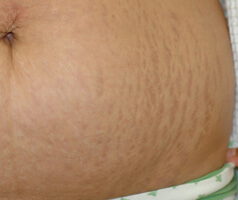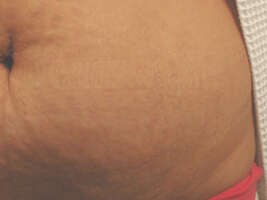- Home
- Injections
- Laser Treatments
- Specialties
Specialtiesview all
- Other Treatments
- Before After Photos
Before After Photosview all
- Contact Us
- Doctor And Staff
- About Celibre
- Blogs
There’s no “stretching” the truth that no matter how old you are or whether you’re male or female, if you have stretch marks, you hate them. Maybe you’ve just gone through a pregnancy, gained a bunch of muscle mass or had a rapid change in weight? These scenarios and even general growth during adolescence can be cause stretch marks to appear.
Not everyone’s stretch marks look the same. Some are angry and reddish color. Others are dark or some shade of brown. Finally, some are white or silvery distinctly lighter than the surrounding skin tone. In addition to the range of colors, some stretch marks are flat or flush with the surrounding skin surface while others are more textured, making them look indented or sunk-in.

 No matter what they look like, stretch marks are all caused by a breakdown or tearing in the skin’s connective tissue. Elastic and collagen fibers simply snap under the intense pressure to stretch and cover the body area that is increasing in size. While many people have speculated as to why stretch marks happen for some and not others, we still don’t know. One thing we do know is that they are genetic. If your mom, dad, or someone else in your immediate family has them, chances are that you will too, no matter what preventative steps you take to avoid them.
No matter what they look like, stretch marks are all caused by a breakdown or tearing in the skin’s connective tissue. Elastic and collagen fibers simply snap under the intense pressure to stretch and cover the body area that is increasing in size. While many people have speculated as to why stretch marks happen for some and not others, we still don’t know. One thing we do know is that they are genetic. If your mom, dad, or someone else in your immediate family has them, chances are that you will too, no matter what preventative steps you take to avoid them.
Why would one person in my family have stretch marks and not another?
No one has a direct answer to this question. Just like siblings can have either brown or blue eyes, it all depends on the genes that you inherit. We believe there are certain genetic factors that make some people more disposed to developing stretch marks than others, even someone in your immediate family.
Are my stretch marks permanent?
In most cases, yes as they are a type of scar. However, laser treatments can significantly alter the color improve texture.
Are there any creams or lotions that I can use to prevent or fade my stretch marks?
Not to our knowledge. The creams out there that claim to fade stretch marks often do so with ingredients that “plump” the skin around them. This effect is usually lost once you stop using the cream, so it really isn’t an effective treatment and certainly not a cure. No matter what you do to prevent them, stretch marks will usually happen anyway if you’re genetically predisposed to developing them.
Why do some stretch marks look different than others?
The reasons why people develop stretch marks can differ, but they all share the common thread of the skin’s inability to accommodate a change in size or the inability of the skin to “stretch” to keep up. The reason that you see different colors (red, brown, white) is largely due to a person’s skin type (color) and how long the stretch mark has been there.
New stretch marks on those with lighter skin (Caucasian, etc.) are usually angry and red. Sometimes, these will eventually fade a bit to a lighter shade with time. Sometimes, they are purple in appearance. If your skin is darker, then your stretch marks may be dark brown or some shade of brown. These often don’t fade with time. White stretch marks are usually ones that have been around for quite some time. They are older and much more difficult to treat because they’ve lost most of the pigmentation in the skin.
Which type of laser treats which type of stretch mark?
Usually, both red and brown stretch marks can be treated with lasers. Pulsed dye lasers work well to target the blood vessels that make up the color of red stretch marks, and q-switched lasers target the excess pigmentation, or melanin, that give brown stretch marks their dark color.
White or hypo-pigmented stretch marks are often the toughest to treat because they don’t have an easy target for a laser to see. Also, we don’t yet have a laser that can stimulate these white marks to make more pigment to help them blend in with the surrounding normal skin. With lighter stretch marks, we focus on using lasers to improve the surrounding skin’s texture which actually helps a lighter stretch look less obvious.
Which lasers does Celibre Medical use to treat stretch marks?
Celibre is unique in that we have many different lasers and are able to mix and match to develop the perfect treatment plan for you. Our nurses are the best in the business and know these devices inside and out which helps them tailor your plan and alter it as needed.
We use the Aramis Quantel to stimulate new collagen and remodel what’s already there. This laser works by using heat. This is important when we can’t target a specific color in a stretch mark (red or brown). By building collagen in the skin around it, the stretch mark shrinks a bit and looks less obvious. We use a pulsed dye laserto target the redness and a Q-switched laser to fade brown, hyper-pigmented stretch marks.
In many of our patients, we’ll use a combination of all three of these lasers. If you’re a researcher, then you may have read about other facilities that use fractionated, erbium or plasma lasers with or instead of some of the options listed above. While there’s nothing wrong with this approach, we have found in our experience that we get the same results by skipping these more aggressive, expensive lasers that require recovery time.
What should my expectations be if I have laser treatment of my stretch marks?
In a word: realistic. At Celibre Medical, we won’t promise you results that we know we can’t deliver. Instead, we’ll tell you to expect the minimum amount of improvement, and if we get more (which we usually do), then everyone’s happy! Any facility that promises to completely eliminate or erase stretch marks is trying to sell you something, not take care of you. If it sounds too good to be true, then it usually is.
Are there specific questions that I need to ask during my consultation?
Our general advice is to make sure you understand the how and why of everything that’s being proposed to you. A couple of suggestions would be:
Can any skin type (color) have laser treatment for stretch marks?
Yes! The lasers that we’ve discussed here can all be safely used on any skin type (color). Another bonus is that they are all no downtime treatments which means you can get right back to your life afterwards.
How long do the laser treatments take?
It really depends on how many stretch marks we’re treating. If you have only a few, the laser treatment may last a short 15 to 20 minutes. More extensive stretch marks may require an hour or so to treat.
Is there anyone who is not a candidate for laser treatment of stretch marks?
In our practice, we pride ourselves on our integrity. We won’t treat the following people:
How do I know if a tummy tuck would be a better choice for me?
We don’t pretend to be plastic surgeons. With that said, we can give you an idea if you have enough excess skin or abdominal tissue to qualify as a surgical candidate. We’ll also tell you that if your stretch marks extend up above your belly button, then you can expect that a surgery will not remove them completely. Most of these patients can have only 50% to 60% removed with this type of surgery.
When should I have laser treatment of my stretch marks?
Current research shows that the sooner they are treated, the better your results will be. We believe this is because the laser disrupts some of the continued inflammatory process that happens during the formation of a stretch mark. Halting the process makes it easier to rebuild the skin and reverse the visible effect.

